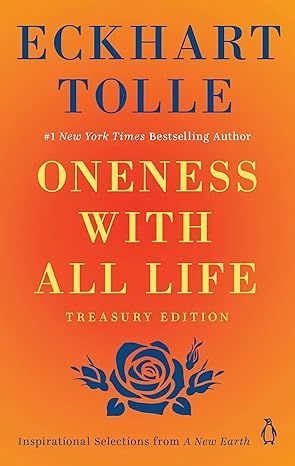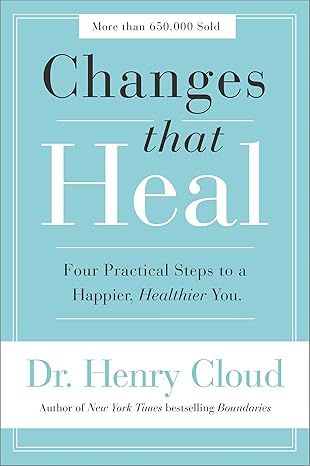Stillness Speaks : Whispers of Now
4.7
-
6,345 ratings
New York Times bestselling author Eckhart Tolle — Learn the transformative power of living in the now
Attaining Eckhart Tolle’s state of presence: In Stillness Speaks, Eckhart Tolle illuminates the fundamental elements of his teaching, addressing the needs of the modern seeker by drawing from all spiritual traditions. At the core of the book is what the author calls “the state of presence,” a living in the ‘now’ that is both intensely inspirational and practical.
The power of now: When the pressures of future and past thinking disappear, fear and frustration also vanish, conquered by the moment. Stillness Speaks takes the form of 200 individual entries, organized into 10 topic clusters that range from “Beyond the Thinking Mind” to “Suffering and the End of Suffering.” Each entry is concise and complete in itself, but, read together, take on a transformative power.
If you have read The Untethered Soul by Michael Singer, Buddha’s Brain by Rick Hanson, or other Eckhart Tolle books such as The Power of Now, you will want to own and read Stillness Speaks.
Kindle
$7.46
Available instantly
Audiobook
$0.00
with membership trial
Hardcover
$10.89
Paperback
$14.79
Ships from
Amazon.com
Payment
Secure transaction
ISBN-10
0340829745
ISBN-13
978-0340829745
Print length
144 pages
Language
English
Publisher
Mobius
Publication date
December 31, 2002
Dimensions
4.97 x 0.31 x 7.72 inches
Item weight
2.31 pounds
Popular highlights in this book
Your unhappiness ultimately arises not from the circumstances of your life but from the conditioning of your mind.
Highlighted by 2,214 Kindle readers
Here is a new spiritual practice for you: don’t take your thoughts too seriously.
Highlighted by 2,182 Kindle readers
Sometimes surrender means giving up trying to understand and becoming comfortable with not knowing.
Highlighted by 2,117 Kindle readers
Product details
ASIN :
B00149ZWSQ
File size :
2000 KB
Text-to-speech :
Enabled
Screen reader :
Supported
Enhanced typesetting :
Enabled
X-Ray :
Enabled
Word wise :
Enabled
Editorial reviews
"Tolle describes stillness with eloquent economy." -- Publishers Weekly (Publisher's Weekly )
Sample
INTRODUCTION
A true spiritual teacher does not have anything to teach in the conventional sense of the word, does not have anything to give or add to you, such as new information, beliefs, or rules of conduct. The only function of such a teacher is to help you remove that which separates you from the truth of who you already are and what you already know in the depth of your being. The spiritual teacher is there to uncover and reveal to you that dimension of inner depth that is also peace.
If you come to a spiritual teacher — or this book — looking for stimulating ideas, theories, beliefs, intellectual discussions, then you will be disappointed. In other words, if you are looking for food for thought, you won’t find it, and you will miss the very essence of the teaching, the essence of this book, which is not in the words but within yourself. It is good to remember that, to feel that, as you read. The words are no more than signposts. That to which they point is not to be found within the realm of thought, but a dimension within yourself that is deeper and infinitely vaster than thought. A vibrantly alive peace is one of the characteristics of that dimension, so whenever you feel inner peace arising as you read, the book is doing its work and fulfilling its function as your teacher: it is reminding you of who you are and pointing the way back home.
This is not a book to be read from cover to cover and then put away. Live with it, pick it up frequently, and, more importantly, put it down frequently, or spend more time holding it than reading it. Many readers will feel naturally inclined to stop reading after each entry, to pause, reflect, become still. It is always more helpful and more important to stop reading than to continue reading. Allow the book to do its work, to awaken you from the old grooves of your repetitive and conditioned thinking.
The form of this book can be seen as a revival for the present age of the oldest form of recorded spiritual teachings: the sutras of ancient India. Sutras are powerful pointers to the truth in the form of aphorisms or short sayings, with little conceptual elaboration. The Vedas and Upanishads are the early sacred teachings recorded in the form of sutras, as are the words of the Buddha. The sayings and parables of Jesus, too, when taken out of their narrative context, could be regarded as sutras, as well as the profound teachings contained in the Tao Te Ching, the ancient Chinese book of wisdom. The advantage of the sutra form lies in its brevity. It does not engage the thinking mind more than is necessary. What it doesn’t say — but only points to — is more important than what it says. The sutra-like character of the writings in this book is particularly marked in chapter 1 (“Silence &Stillness”), which contains only the briefest of entries. This chapter contains the essence of the entire book and may be all that some readers require. The other chapters are there for those who need a few more signposts.
Just like the ancient sutras, the writings contained within this book are sacred and have come out of a state of consciousness we may call stillness. Unlike those ancient sutras, however, they don’t belong to any one religion or spiritual tradition, but are immediately accessible to the whole of humanity. There is also an added sense of urgency here. The transformation of human consciousness is no longer a luxury, so to speak, available only to a few isolated individuals, but a necessity if humankind is not to destroy itself.At the present time, the dysfunction of the old consciousness and the arising of the new are both accelerating. Paradoxically, things are getting worse and better at the same time, although the worse is more apparent because it makes so much “noise.”
This book, of course, uses words that in the act of reading become thoughts in your mind. But those are not ordinary thoughts — repetitive, noisy, self-serving, clamoring for attention. Just like every true spiritual teacher, just like the ancient sutras, the thoughts within this book don’t say, “Look at me,” but “Look beyond me.” Because the thoughts came out of stillness, they have power — the power to take you back into the same stillness from which they arose. That stillness is also inner peace, and that stillness and peace are the essence of your Being. It is inner stillness that will save and transform the world.
CHAPTER I
SILENCE & STILLNESS
When you lose touch with inner stillness, you lose touch with yourself. When you lose touch with yourself, you lose yourself in the world.
Your innermost sense of self, of who you are, is inseparable from stillness. This is the I Am that is deeper than name and form.
Stillness is your essential nature. What is stillness? The inner space or awareness in which the words on this page are being perceived and become thoughts. Without that awareness, there would be no perception, no thoughts, no world.
You are that awareness, disguised as a person.
The equivalent of external noise is the inner noise of thinking. The equivalent of external silence is inner stillness.
Whenever there is some silence around you — listen to it. That means just notice it. Pay attention to it. Listening to silence awakens the dimension of stillness within yourself, because it is only through stillness that you can be aware of silence.
See that in the moment of noticing the silence around you, you are not thinking. You are aware, but not thinking.
When you become aware of silence, immediately there is that state of inner still alertness. You are present. You have stepped out of thousands of years of collective human conditioning.
Look at a tree, a flower, a plant. Let your awareness rest upon it. How still they are, how deeply rooted in Being. Allow nature to teach you stillness.
When you look at a tree and perceive its stillness, you become still yourself. You connect with it at a very deep level. You feel a oneness with whatever you perceive in and through stillness. Feeling the oneness of yourself with all things is true love.
Silence is helpful, but you don’t need it in order to find stillness. Even when there is noise, you can be aware of the stillness underneath the noise, of the space in which the noise arises. That is the inner space of pure awareness, consciousness itself.
You can become aware of awareness as the background to all your sense perceptions, all your thinking. Becoming aware of awareness is the arising of inner stillness.
Any disturbing noise can be as helpful as silence.How? By dropping your inner resistance to the noise, by allowing it to be as it is, this acceptance also takes you into that realm of inner peace that is stillness.
Whenever you deeply accept this moment as it is — no matter what form it takes — you are still, you are at peace.
Pay attention to the gap — the gap between two thoughts, the brief, silent space between words in a conversation, between the notes of a piano or flute, or the gap between the in-breath and out-breath.
When you pay attention to those gaps, awareness of “something” becomes — just awareness. The formless dimension of pure consciousness arises from within you and replaces identification with form.
True intelligence operates silently. Stillness is where creativity and solutions to problems are found.
Is stillness just the absence of noise and content? No, it is intelligence itself — the underlying consciousness out of which every form is born. And how could that be separate from who you are? The form that you think you are came out of that and is being sustained by it.
It is the essence of all galaxies and blades of grass; of all flowers, trees, birds, and all other forms.
Stillness is the only thing in this world that has no form. But then, it is not really a thing, and it is not of this world.
When you look at a tree or a human being in stillness, who is looking? Something deeper than the person. Consciousness is looking at its creation.
In the Bible, it says that God created the world and saw that it was good. That is what you see when you look from stillness without thought.
Do you need more knowledge? Is more information going to save the world, or faster computers, more scientific or intellectual analysis? Is it not wisdom that humanity needs most at this time?
But what is wisdom and where is it to be found? Wisdom comes with the ability to be still. Just look and just listen. No more is needed. Being still, looking, and listening activates the non-conceptual intelligence within you. Let stillness direct your words and actions.
Read more
About the authors
Eckhart Tolle
Eckhart Tolle was born in Germany. When he was 29, a profound spiritual transformation virtually dissolved his old identity and radically changed the course of his life. He is now a counsellor and spiritual teacher, and the author of The Power of Now, Practising the Power of Now and Stillness Speaks. He lives in Vancouver.
Reviews
Customer reviews
4.7 out of 5
6,345 global ratings
Michael Tisdale
5
Good Short Read
Reviewed in the United States on April 14, 2024
Verified Purchase
Almost a “pocket guide” to his other longer books. Worth reading. About an hour to read. Worth buying and putting on a shelf to reread.
2 people found this helpful
Cindy's closet
5
❤️ 😍 💖 ❣️ 💕 💘 ❤️ 😍
Reviewed in the United States on June 23, 2024
Verified Purchase
This literary work is quite enjoyable and intellectually stimulating.
2 people found this helpful
Debra
5
Amazing read
Reviewed in the United States on July 31, 2024
Verified Purchase
This book simplifies life on a mental and spiritual level level. It encourages me to sit still and enjoy each moment.
Top Eckhart Tolle titles
View all
Oneness With All Life: Awaken to a life of purpose and presence with the Number One bestselling spiritual author
4.8
-
2,119
$9.99

Practicing the Power of Now: Essential Teachings, Meditations, And Exercises From the Power of Now (16pt Large Print Edition)
4.7
-
5,712
$1.42

A New Earth: Awakening to Your Life's Purpose (Oprah's Book Club, Selection 61)
4.7
-
18,620
$1.62

The Power of Now: A Guide to Spiritual Enlightenment
4.7
-
61,710
$1.77
Similar Books

Changes That Heal: Four Practical Steps to a Happier, Healthier You
4.8
-
2,937
$0.99

Necessary Endings: The Employees, Businesses, and Relationships That All of Us Have to Give Up in Order to Move Forward
4.7
-
2,598
$0.99

Trust: Knowing When to Give It, When to Withhold It, How to Earn It, and How to Fix It When It Gets Broken
4.8
-
626
$0.99

Boundaries Updated and Expanded Edition: When to Say Yes, How to Say No To Take Control of Your Life
4.7
-
23,877
$0.99

Braving the Wilderness: The Quest for True Belonging and the Courage to Stand Alone
4.6
-
14,403
$0.99

The Gifts of Imperfection: 10th Anniversary Edition: Features a new foreword and brand-new tools
4.7
-
42,318
$0.99
Best sellers
View all
The Tuscan Child
4.2
-
100,022
$8.39

The Thursday Murder Club: A Novel (A Thursday Murder Club Mystery)
4.3
-
155,575
$6.33

Sapiens: A Brief History of Humankind
4.6
-
140,302
$13.49

The Butterfly Garden (The Collector, 1)
4.3
-
88,556
$9.59

Things We Hide from the Light (Knockemout Series, 2)
4.4
-
94,890
$11.66

The Last Thing He Told Me: A Novel
4.3
-
154,085
$2.99

The Perfect Marriage: A Completely Gripping Psychological Suspense
4.3
-
143,196
$9.47

The Coworker
4.1
-
80,003
$13.48

First Lie Wins: A Novel (Random House Large Print)
4.3
-
54,062
$14.99

Mile High (Windy City Series Book 1)
4.4
-
59,745
$16.19

Layla
4.2
-
107,613
$8.99

The Locked Door
4.4
-
94,673
$8.53

